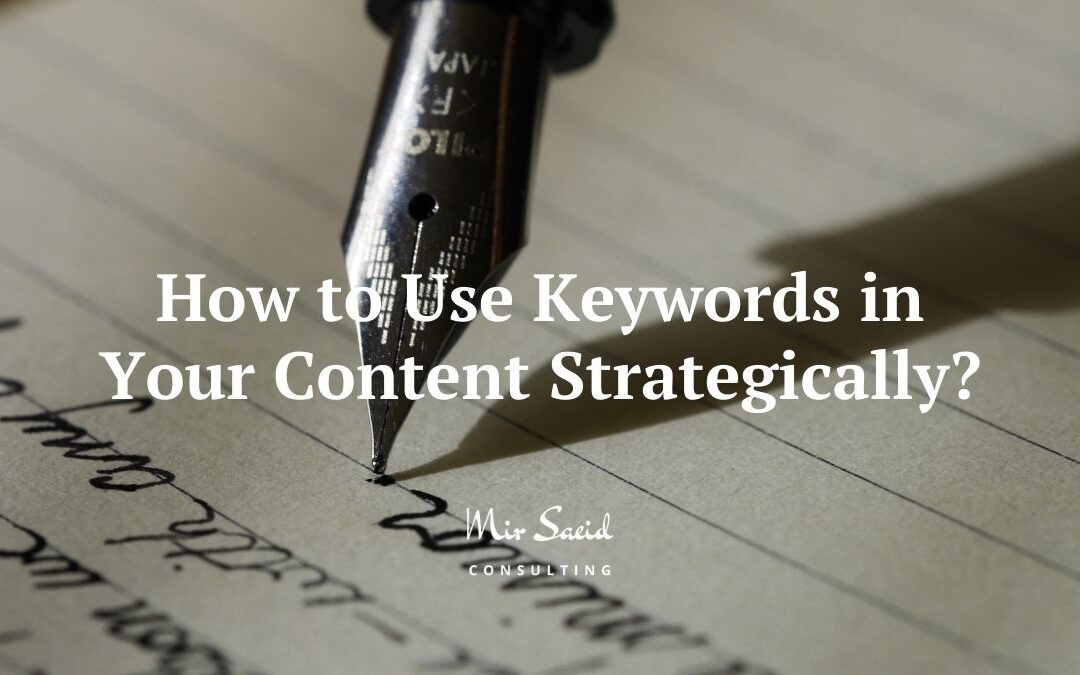Given that search engines use keywords as a jumping-off point when filtering outcomes, it’s notably important to ensure you recognize a way to use key phrases in your content efficaciously so that it has a better chance of being determined, listed, and ranked.
Even as there are numerous critiques on the way to use key phrases for SEO, we want to offer you a fundamental and short step-through-step guide on how to correctly and safely use key phrases in any type of SEO content material that you publish.
How many key phrases should you put on a page?
While speaking approximately on what number of keywords are to be used to create awareness about a page, the answer relies a lot on the keywords you’re wanting to use, how associated they may be to each other, and how they help push the message of the content material ahead. With the right keyword research, though, it shouldn’t be too tough to give you a listing of 5-10 keywords. That being stated, it isn’t suggested you have all 10!
Let’s first talk about the policies of keyword hierarchy. There are 3 foremost kinds of keywords for search engine optimization:
1. Primary key-word
2. Secondary key phrases
3. Extra key phrases
Your number one keyword has to be the principal recognition of the entire article, so the title and resulting content need to replicate that. You couldn’t sincerely write a great piece of content material about two separate subjects, so the one handiest primary keyword must be used to drive the content material forward.
Secondary keywords are complementary key phrases to the primary one, but simply mild versions. Commonly, the main subject matter will consist of three-five primary speaking points so the use of a handful of those secondary keywords makes sense.
Extra keywords are just any other associated key phrases that are phrased or spelled differently than the first but suggest an identical factor. This is a seize-all process to get one-of-a-kind variation of your principal keyword. Commonly, long-tail key phrases might be included in this category.
What’s the number of key phrases for SEO?
In most cases, it might be 3-8 in total, primarily based on the length of the content. This breaks down into 1 primary keyword, 1-3 secondary keywords, and 1-4 extra key phrases. This gives you a fighting chance to start ranking higher. Down the road, you could even re-optimize your content material based on where it’s present ranking lies.
The usage of greater than eight or so key phrases can come off as spammy. Additionally, it’s exceedingly hard to clearly contain that many keywords for search engine optimization into writing, and absolutely isn’t necessary. What you’ll find is that associated keywords will certainly and robotically come up while writing content, based totally around a few absolutely suitable keywords. Doing extra than this normally hurts clarity and stands out like a sore thumb to readers in addition to Google’s web page crawlers.
Where to use keywords for search engine optimization in your content material?
It’s easy to just say ‘you need to add keywords for SEO’. It’s far more difficult practicing this. But there are sure regulations for adding key phrases to a website that could make your SEO efforts profitable.
Insert keywords into your content following these steps:
1. Use keywords in your meta description
This is one of the primary approaches to add key phrases for search engine optimization, however, it’s frequently not noted. The meta description acts as a simple synopsis to describe what the content material is about, so setting the keyword on this precis helps Google to better filter your results. It is a powerful way to get 1 or 2 of your most crucial keywords attached to the part of your page that’s without delay served up by using SERPs.
As a refresher, a meta description is a 20-25 worded phrase, a description of what your web page is all about. This description is what shows up under a web page name and URL when people search for a keyword phrase on search engines like Google and Yahoo.
Way to use keywords for search engine optimization in a meta description
First, it’s crucial to have the right equipment. If you’re employing WordPress, try downloading the Yoast search engine optimization plugin. This little plugin lets you to quickly optimize your content material for both search engine optimization and readability, as well as gives you spots to go in for your meta description and search engine optimization name tag.
While using search engine optimization key phrases in a meta description, ensure to use the key-word at least once, but no more than two times. Make sure to prioritize a beneficial, engaging description of the key-word, in view that this is the primary thing someone will read before visiting your website.
Search engine optimization seasoned tip: If you can get a secondary keyword on your meta along with one example of your primary, you’re killing it in relation to the use of keywords for search engine optimization.
2. Insert keywords to your search engine optimization name tag
First things first, let’s get a few useful keyword records in your SEO title tag. This name tag is just like the meta description. This title can be clickable from the search engines like Google and Yahoo and will take the consumer at once to your web page.
3. Use key phrases in your article to identify
If feasible, place the key-word within the name of your content material, in view that Google identifies this header along with your meta description to paint a photo of what your content material is about. Having the key-word inside the identity is very helpful.
If the key-word can’t be used clearly in the identity, use a version that still gets the fact of the object across whilst hitting a number of the principal words from your keyword phrase. A little is higher than nothing!
4. Use keywords inside the first two hundred phrases
Many specialists accept that Google gives more weight to the first 200 words of your content material. The reason why is because generally, the primary 100-200 words of an article is where the author sets up the introduction of what’s going to be mentioned.
Where to use keywords in a piece of writing?
Understanding that Google scrutinizes the first 200 phrases of a weblog post, it’s vital to ensure that you put your number one key-word inside the first sentence or paragraph, if in any respect feasible, without sacrificing the niceness of the content material. In addition, you have to try to use at least one secondary key-word in the first 200 phrases as well.
Remember that Google is making an attempt to get an ordinary picture of what the article is all about. You have to be cautious to lead Google to the key phrases you want it to attend and not confuse it when optimizing content for keywords. This means your primary keyword has to live in all of the maximum critical places, your secondary keywords next, after which some other extra keywords would arrive. Consider it as a pyramid of utilization, with primary key phrases at the pinnacle.
5. Insert keywords clearly throughout the article
It’s only human to forget that the reader genuinely comes first. But you never compromise your reader’s capacity to be engaged, informed, and enlightened by your content material because of horrific keyword placement. Though it takes place all the time.
Use ‘stop phrases’ in keyword terms
One way to help you write key phrases clearly is to make use of ‘stop phrases’ in your keyword writing. Those are phrases that can be delivered within key-word phrases to examine them without decreasing their rating cost. You could, without difficulty, discover a listing of generally used forestall words to utilize when adding keywords to your website.
What number of key phrases should you put in your content?
This is a query that’s frequently discussed and argued about. The real solution is that it completely depends on the kinds of keywords you’ve got and the length of your content.
The overall rule is you ought to try and encompass your primary key-word about once every 100-150 words. So in case, you’re writing a 1000 word article, putting the number one key-word around 7-10 instances might be appropriate. Also, keep in mind that you want to distribute these instances of the key-word for the whole duration of the piece. You don’t need all 7 instances of your primary keyword within the same 200 word section.
Secondary and extra key phrases shouldn’t be in the article greater than your number one key-word. Anything your baseline is for the use of your number one keyword for your content, lower by way of about 25% for secondary and every other 25% for extra keywords for search engine optimization. Then you can keep a healthy keyword shape that Google crawlers should effortlessly be able to observe.
6. Use keywords within the ultimate 200 phrases
Much like how an introduction of a piece is essential to keyword rankings as it sets the framework for the content material. For this reason, try to encompass your number one keyword more close to the closing or second to the remaining paragraph and include a secondary key-word if possible.
For weblog posts, it’s a commonly accurate exercise to include a call-to-action (or CTA) within the final paragraph.
7. Use keywords in headings (h1s, h2s, h3s, and so forth)
Headings are a formatting tool that maximum text editors provide to help split your textual content. Big chunks of paragraphs without a heading are intimidating and frequently skipped. Using headings to break up content allows you to visually move the reader along to the vital points, or those they are most inquisitive about.
From an SEO point of view, headings might be even critical. The HTML tags used to pick out h1s, h2s, h3s, and many others are also ranking signals for Google to recognize what’s most crucial inside the content material. Adding key phrases to headings in content can be a single great way to try to rank. More the content material, more the headings you’ve got – so longer content material commonly ranks higher than shorter content.
When a keyword is utilized in headings, it brings more emphasis to the means and importance of the key phrases. This facilitates the engines like Google to recognize how relevant the key phrases are to your content material.
A way to upload key phrases to heading 1s (h1s)
Heading 1s, or h1s, are commonly reserved only for the principal name of the article. If you use a couple of h1s for your content material, you’re basically burdening Google. Rather, just keep a single h1 in your article identifying with your primary key-word.
A way to use keywords in heading 2s (h2s)
Heading 2s, or h2s, are in which you can do the bulk of putting vital keywords. h2s are the headings that break up the principle sections of your content and commonly come into play each couple hundred words. For a thousand phrase article, you could plan on around 3-5 of these h2s.
A way to insert key phrases to heading 3s (h3s)
Heading 3s, or h3s, are used to help break up and list character points in the foremost sections. You might find h3s in the shape of numbered lists or clarifying sections to an h2 heading. That is another great area for putting a primary, but likely a higher spot for secondary keywords and any additional key phrases you have got.
8. Use key phrases in anchor text links
When a keyword is used as an anchor text content link, it implies that there may be a place to find even greater information concerning that word. This helps to introduce emphasis on the key-word and impart relevance to the content it’s being linked to.
The use of keywords as anchor text content hyperlinks in your articles can help different pages on your site. This is additionally known as developing an inner link structure displaying Google wherein the maximum crucial articles are for precise keyword terms. If you may plan your content material, for this reason, you already know you can use anchor text links of certain keyword phrases to power the authority of different ‘pillar’ pieces.
Search engine optimization pro tip: Do not use your primary keyword (or a variation of it) in anchor text that is linking to another page until you’ve completely given up the wish of ranking for that key-word on that web page. Doing this basically tells Google to ignore that key-word on the web page you’re operating on and to search for it in the web page you’re linking to. This is a commonplace mistake that quite a few content material entrepreneurs make. Rather, find an associated topic within your article with an associated key-word that you may hyperlink to another web page to help improve its authority. For any of the principle key phrases you wish to rank for on the page you’re working on, do not hyperlink out to other pages using them because of the anchor text.
9. Use keywords in image alt-tags
In case you aren’t using pictures for your content writing, then please do that! We can’t overemphasize enough what number of opportunities you’re missing out in case you aren’t using some form of visual cue to interact and tell your readers and potential clients about your piece. Photographs and content writing (and films for that matter) are great in terms of user engagement.
The way to use SEO key phrases in alt tags
In terms of key-word usage, the use of your key phrases in a picture alt-tag can assist it to come up in all picture searches. This could help users to be led to your content material in a proper manner.
Not only do photos help doll up the text and supply it color, character, and appeal, these additionally can be an amazing possibility to upload key phrases for SEO for your website. Take advantage of putting pictures in your articles.
10. Use key phrases in the URL
To include keywords on your website, you need to continually try and put your primary keyword within the important web page URL of the subject you’ve written about. In case you’ve carried out the steps above and placed your primary key-word in the title of your article, it ought to be in the URL when you publish it. In case your title is similar to the main keyword but doesn’t include it absolutely, you must tweak your page URL to encompass it.
Caution: Avoid key-word stuffing
This can be an issue! A part of the ability to optimize key phrases for your content consists of showing restraint.
So, don’t overuse key phrases for SEO.
Google is a whole lot smarter than it was in the early years and may without difficulty tell if you are keyword stuffing for search engine optimization purposes. If Google suspects you’re just using key phrases for search engine optimization and not for user intent, you may get penalized. Keyword stuffing is never worth it, so don’t waste time doing it.
Tune, refine, and use exceptional key phrases if necessary
Don’t neglect the fact that you may re-optimize your posts in some months as soon as the dust has settled. Provide your content material about 3 months of time before you decide to make any real changes, then pass and see what keywords it’s ranking for, and optimize in addition from there. In case your submission is rating higher for a secondary or extra key-word than the preliminary ‘primary keyword’, then switch your primary key-word for search engine optimization!
Simply make certain to be careful about making huge modifications or you can capsize the entire content boat. Make small adjustments to optimize key phrases and see if the outcomes are favorable. Do this time and again to have a pleasant-tuned content advertising approach in your hands.
At the end: How to use keywords for SEO?
- Attention on 3-8 keywords totally consistent with the article (number one, secondary and then extra).
- Upload key phrases to meta descriptions, meta name tags, and web page URLs.
- Use key phrases to identify headers, alt-photograph tags.
- Insert key phrases in the first and closing paragraphs and all through your piece.
- If it doesn’t work, don’t use it. Keywords need to be applicable and fairly relevant to your content material. If the word is unusual or doesn’t shape your subject, use it precisely and not its edited version.
- Even as key phrases are terrific, the content is what you must be cognizant of. Keyword-riddled content facilitates no one and Google will not rank your content until it helps any individual.
So there you have it, essentially the whole thing you may ever need to understand about the way to use SEO key phrases in your writing.
You can seek the help of my digital marketing service agency in case SEO is worrying you. You may also reach us for Website Development and Digital Marketing in Toronto.
More posts:
- How to Find Secondary Keywords to Boost Your Rankings?
- Who is an SEO consultant & What’ll he do for you?
- How to Become a Social Media Expert?

Mir is a British-educated Digital Marketing Expert with 10+ years of experience in the B2B, D2C, and eCommerce Industries. Having worked with 50+ startups and SMEs, he has a clear understanding of what it takes to establish growth on online platforms.
He is also the Founder of Kashmirica, a social impact brand that aims to take exclusives from Kashmir to the Global consumer. An enthusiastic cultural entrepreneur, Mir is driven by a passion to bring about a social impact.
An avid reader, he loves writing about marketing, and entrepreneurship.













